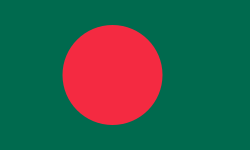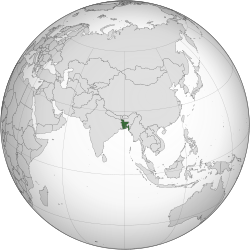
Back Бангладеш Abkhazian Bangladèsh ACE Бангладеш ADY Bangladesj Afrikaans Bangladesch ALS ባንግላዴሽ Amharic Bangladesh AMI Bangladesh AN Bængladesc ANG बांग्लादेश ANP
People's Republic of Bangladesh | |
|---|---|
| Anthem: আমার সোনার বাংলা (Bengali) Amar Sonar Bangla "My Golden Bengal" Notuner Gaan "The Song of Youth" | |
| Government Seal | |
| Capital and largest city | Dhaka 23°45′50″N 90°23′20″E / 23.76389°N 90.38889°E |
| Official language and national language | Bengali[1][2][A] |
| Ethnic groups (2022 census)[3] | 99% Bengali |
| Religion (2022 census)[4] | |
| Demonym(s) | Bangladeshi |
| Government | Unitary parliamentary republic under an interim government |
| Mohammed Shahabuddin | |
| Muhammad Yunus | |
| Syed Refaat Ahmed | |
| Legislature | Jatiya Sangsad |
| Establishment | |
| 15 August 1947 | |
| 14 October 1955 | |
| 26 March 1971 | |
• Victory | 16 December 1971 |
| 16 December 1972 | |
| Area | |
• Total | 148,460[5] km2 (57,320 sq mi) (92nd) |
• Water (%) | 6.4 |
• Land area | 130,170 km2[6] |
• Water area | 18,290 km2[6] |
| Population | |
• 2023 estimate | 171,466,990[7] (8th) |
• 2022 census | 169,828,911[8][9] (8th) |
• Density | 1,165/km2 (3,017.3/sq mi) (13th) |
| GDP (PPP) | 2025 estimate |
• Total | |
• Per capita | |
| GDP (nominal) | 2025 estimate |
• Total | |
• Per capita | |
| Gini (2022) | medium inequality |
| HDI (2022) | medium (129th) |
| Currency | Taka (৳) (BDT) |
| Time zone | UTC+6 (BST) |
| Calling code | +880 |
| ISO 3166 code | BD |
| Internet TLD | |
Bangladesh,[a] officially the People's Republic of Bangladesh,[b] is a country in South Asia. It is the eighth-most populous country in the world and among the most densely populated with a population of over 171 million within an area of 148,460 square kilometres (57,320 sq mi). Bangladesh shares land borders with India to the north, west, and east, and Myanmar to the southeast. It has a coastline along the Bay of Bengal to its south and is separated from Bhutan and Nepal by the Siliguri Corridor, and from China by the Indian state of Sikkim to its north. Dhaka, the capital and largest city, is the nation's political, financial, and cultural centre. Chittagong is the second-largest city and the busiest port of the country.
The territory of modern Bangladesh was a stronghold of many Buddhist and Hindu dynasties in ancient history. Following the Muslim conquest in 1204, the Sultanate and Mughal.[15] During the Mughal period, particularly under the Bengal Subah, the region emerged as one of the most prosperous and commercially active parts of the empire, known for its thriving textile industry and agricultural productivity. The Battle of Plassey in 1757 marked the beginning of British colonial rule for the following two centuries. In the aftermath of the Partition of British India in 1947, East Bengal became the eastern and most populous wing of the newly formed Dominion of Pakistan and was later renamed to East Pakistan. Following over two decades of political repression and systematic racism from the West Pakistan-based government, East Pakistan experienced a civil war in 1971; ultimately leading to a war for independence. The Mukti Bahini, with assistance from Indian forces, waged a successful armed revolution; and at the expense of a genocide, Bangladesh became a sovereign nation on 16 December 1971. Post-Independence, Sheikh Mujibur Rahman led the country until his assassination in 1975. Presidency was later transferred to Ziaur Rahman, who himself was assassinated in 1981. The 1980s was dominated by the dictatorship of Hussain Muhammad Ershad, who was overthrown in a mass uprising in 1990. Following the democratisation in 1991, the "Battle of the Begums" between Khaleda Zia and Sheikh Hasina defined the country's politics for the next three decades. Hasina was overthrown in a student–led mass uprising in August 2024, and an interim government led by Nobel laureate Muhammad Yunus was formed.
Bangladesh is a unitary parliamentary republic based on the Westminster system. It is a middle power with the second-largest economy in South Asia. Bangladesh is home to the third-largest Muslim population in the world and the fifth-most spoken native language. It maintains the third-largest military in South Asia and is the largest contributor to the peacekeeping operations of the United Nations. It consists of eight divisions, 64 districts, and 495 sub-districts, and is home to the largest mangrove forest in the world. However, Bangladesh has one of the largest refugee populations in the world and continues to face challenges such as endemic corruption, lack of human rights, political instability, overpopulation, and adverse effects of climate change. It has twice chaired the Climate Vulnerable Forum and is a member of BIMSTEC, SAARC, OIC and the Commonwealth of Nations.
- ^ "The Constitution of the People's Republic of Bangladesh". Ministry of Law, Justice and Parliamentary Affairs. Archived from the original on 10 November 2019. Retrieved 1 February 2017.
- ^ বাংলা ভাষা প্রচলন আইন, ১৯৮৭ [Bengali Language Implementation Act, 1987]. bdlaws.minlaw.gov.bd (in Bengali). Ministry of Law, Justice and Parliamentary Affairs. Archived from the original on 7 January 2024. Retrieved 7 January 2024.
- ^ "Ethnic population in 2022 census" (PDF).
- ^ Cite error: The named reference
censuswas invoked but never defined (see the help page). - ^ "Bangladesh country profile". BBC News. 4 March 2011. Retrieved 18 February 2025.
- ^ a b "Bangladesh". The World Factbook (2025 ed.). Central Intelligence Agency. Retrieved 13 November 2021. (Archived 2021 edition.)
- ^ "Population, total - Bangladesh". World Bank. Retrieved 4 April 2025.
- ^ "Population and Housing Census 2022: Post Enumeration Check (PEC) Adjusted Population" (PDF). Bangladesh Bureau of Statistics. 18 April 2023. Archived (PDF) from the original on 30 May 2023. Retrieved 30 May 2023.
- ^ "Report: 68% Bangladeshis live in villages". Dhaka Tribune. 28 November 2023. Archived from the original on 6 February 2024. Retrieved 6 February 2024.
- ^ a b c d "World Economic Outlook Database, October 2024 Edition. (Bangladesh)". International Monetary Fund. Retrieved 27 January 2025.
- ^ "Gini inequality index – Bangladesh". Retrieved 31 January 2025.
- ^ Nations, United (13 March 2024). "Human Development Report 2023-24". Archived from the original on 18 March 2024. Retrieved 18 March 2024.
- ^ Ara, Rowshon (March 2020). "A Foreign Language or the Second Language: The Future of English in Bangladesh". International Journal of Language Education. 4 (1): 81–95. doi:10.26858/ijole.v4i2.10458 (inactive 13 March 2025). ISSN 2548-8457.
{{cite journal}}: CS1 maint: DOI inactive as of March 2025 (link) - ^ Historical Evolution of English in Bangladesh (PDF). Mohammad Nurul Islam. 1 March 2019. pp. 9–. Archived (PDF) from the original on 5 February 2024. Retrieved 10 November 2023.
- ^ Raychaudhuri, Tapan; Habib, Irfan (eds). The Cambridge Economic History of India: Volume 1, c.1200–c.1750. Cambridge University Press, 1982.
Cite error: There are <ref group=lower-alpha> tags or {{efn}} templates on this page, but the references will not show without a {{reflist|group=lower-alpha}} template or {{notelist}} template (see the help page).
© MMXXIII Rich X Search. We shall prevail. All rights reserved. Rich X Search




